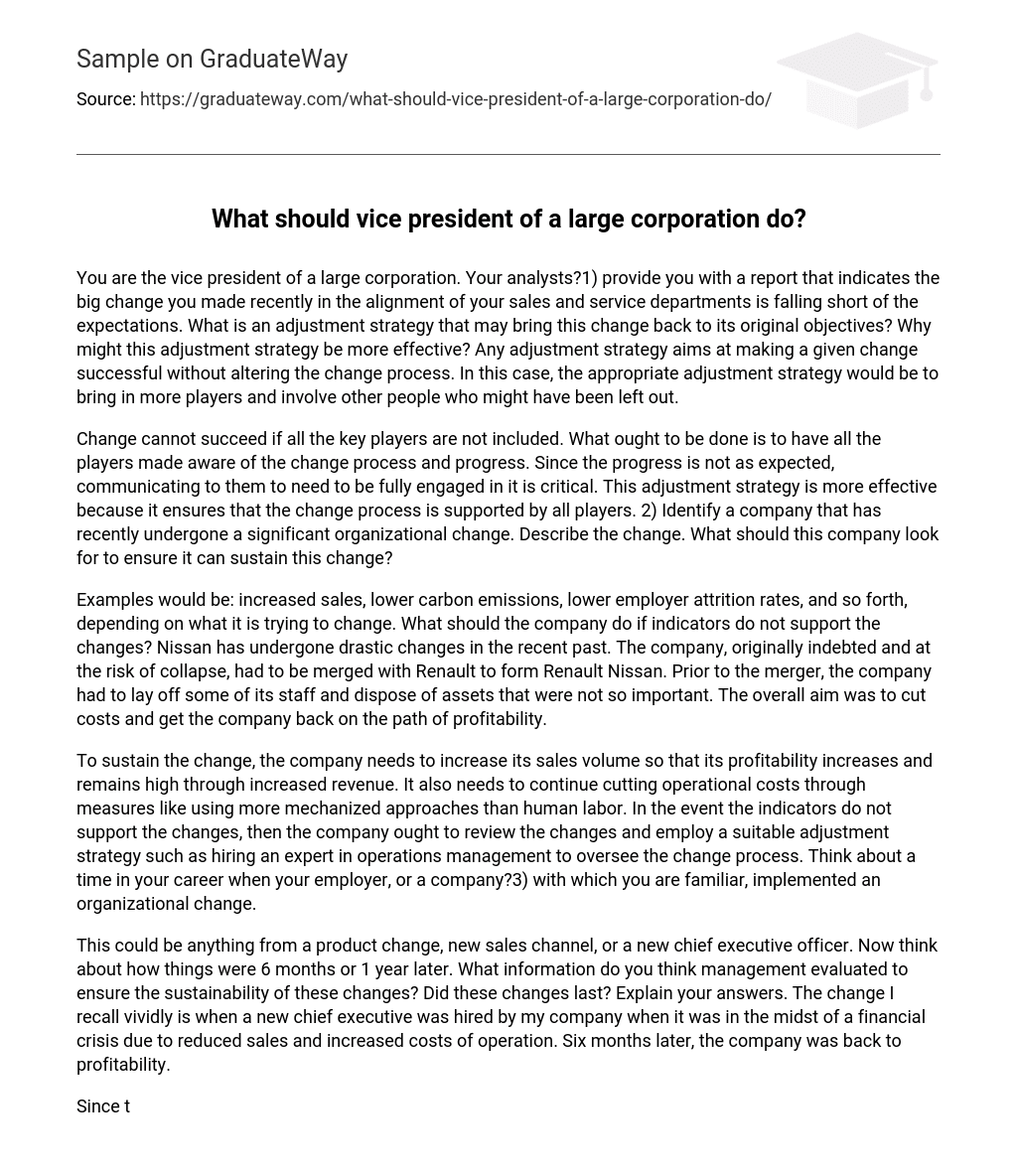You are the vice president of a large corporation. Your analysts?1) provide you with a report that indicates the big change you made recently in the alignment of your sales and service departments is falling short of the expectations. What is an adjustment strategy that may bring this change back to its original objectives? Why might this adjustment strategy be more effective? Any adjustment strategy aims at making a given change successful without altering the change process. In this case, the appropriate adjustment strategy would be to bring in more players and involve other people who might have been left out.
Change cannot succeed if all the key players are not included. What ought to be done is to have all the players made aware of the change process and progress. Since the progress is not as expected, communicating to them to need to be fully engaged in it is critical. This adjustment strategy is more effective because it ensures that the change process is supported by all players. 2) Identify a company that has recently undergone a significant organizational change. Describe the change. What should this company look for to ensure it can sustain this change?
Examples would be: increased sales, lower carbon emissions, lower employer attrition rates, and so forth, depending on what it is trying to change. What should the company do if indicators do not support the changes? Nissan has undergone drastic changes in the recent past. The company, originally indebted and at the risk of collapse, had to be merged with Renault to form Renault Nissan. Prior to the merger, the company had to lay off some of its staff and dispose of assets that were not so important. The overall aim was to cut costs and get the company back on the path of profitability.
To sustain the change, the company needs to increase its sales volume so that its profitability increases and remains high through increased revenue. It also needs to continue cutting operational costs through measures like using more mechanized approaches than human labor. In the event the indicators do not support the changes, then the company ought to review the changes and employ a suitable adjustment strategy such as hiring an expert in operations management to oversee the change process. Think about a time in your career when your employer, or a company?3) with which you are familiar, implemented an organizational change.
This could be anything from a product change, new sales channel, or a new chief executive officer. Now think about how things were 6 months or 1 year later. What information do you think management evaluated to ensure the sustainability of these changes? Did these changes last? Explain your answers. The change I recall vividly is when a new chief executive was hired by my company when it was in the midst of a financial crisis due to reduced sales and increased costs of operation. Six months later, the company was back to profitability.
Since the changes have lasted ever since, I believe management considered factors such as the response from staff to the change and the need to generally formulate of a strategic plan for the change. There must have also been an evaluation of the changes from time to time in order to ascertain the areas that needed improvement. This is because having such a plan ensures that everything follows a preset pattern and only the important issues are focused on. Chapter 12 of the textbook, Managing Organizational Change, ?4) discusses key measures or metrics for evaluating change.
What are these measures and what type of insight does each offer into the success or failure of the change implementation? What might be some shortage of each measure? They include the following: 1. The number of projects completed within a specified period If the projects that are completed in a given period of time are more than those that stalled or are yet to be finished, then the change is successful. Sometimes, however, certain projects might be longer than others, meaning that delays might not necessarily mean failure. 2. Number of cancellations
The more cancellations that are experienced, the lesser the success of the change. The limit of this indicator is that certain cancellations actually enhance change by encouraging specialization on those projects that are deemed more likely to succeed. 3. The turnover rate of teams and project managers If a change calls for hiring or changing of the implementers and managers of the change, then the change is faced with difficulties and its success rating is low. Sometimes, however, a high turnover of teams and change managers can indicate success because changes call for the use of right skills only. 4.
Quantity of active projects Change is only as successful as the number of projects that are under progress. The more progressive the projects the more successful the change. The limitation of this indicator is that although some projects might be progressing and active, they might be destined for the wrong place or finish. 5. Number of stalled projects If projects stall on the way or before completion then this is an indication that the change is not successful. The shortage of this measure is that some projects can be stopped just for evaluation purposes or to allow for teams to have some time of rest.





